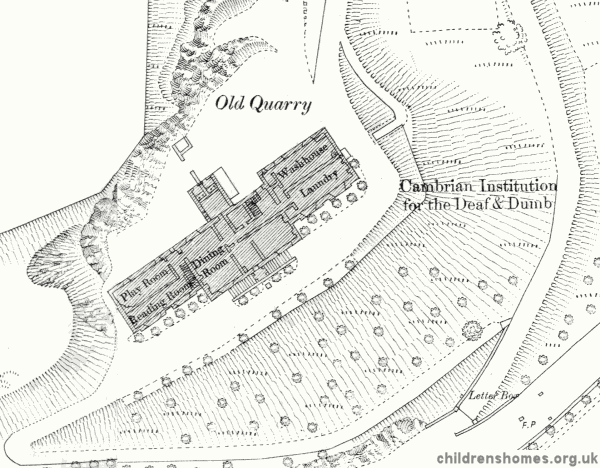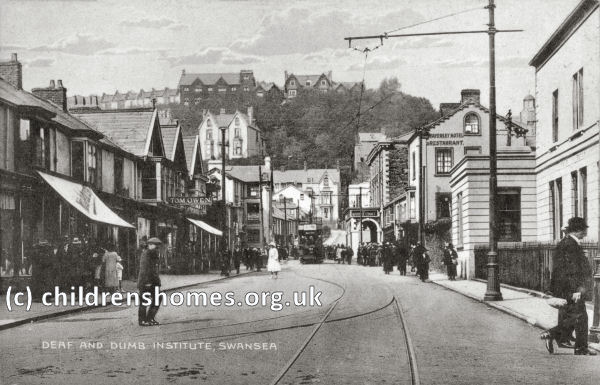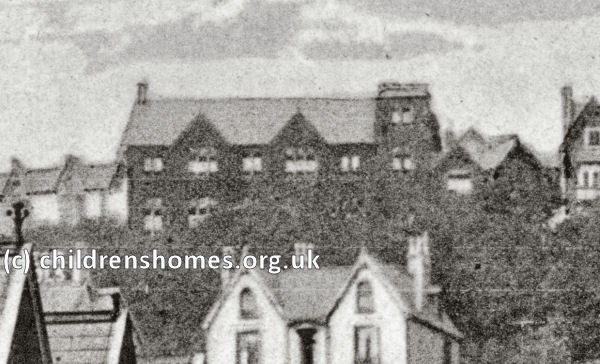Cambrian Institution for the Deaf and Dumb, Swansea, Glamorgan
On 1 February 1847, at a public meeting in Aberystwyth Town hall, Mr Hugh Owen stated that the attention of the Cambrian Educational Society, of which he was the Honorary Secretary, had been drawn to the neglected state of the deaf and dumb in Wales. The Society believed that there were between 500 and 600 such person in the Principality and that and institution for their instruction should be established, with Aberystwyth as its proposed location. A meeting of some of the principal inhabitants of the town had been held on the previous Saturday, at which it was agreed to begin with just 10 or 12 pupils, for whom a house could be rented at £3O or £4O a year. It was not envisaged commencing the scheme before the start of May, by which time the required funds should have been raised. Also present at the meeting was Mr Charles Rhind, the intended Principal of the Institution, who had served eleven years as an Assistant in the London Deaf Institution and for six years as Principal of the Ulster Institution. He was also the brother of James Rhind, master of the Liverpool School for the Deaf and Dumb. Mr Rhind gave an explanation of how the deaf and dumb were instructed. He illustrated his remarks by an examination of deaf and dumb person, named Francis Hancock, who had been educated in the London Institution, and was now a working Engineer at Aberystwyth. A management committee was also appointed at the meeting.
A house was subsequently rented in Pier Street and the Cambrian Institution for the Deaf and Dumb, as it was named, opened on 24 July 1846, with two boys as day pupils. By the following year eight children had been admitted, with admission restricted to those between the ages of 9 and 13.
As commonly happened with such institutions, efforts were made to establish auxiliary branches of the charity in other towns in the region who would raise funds to enable children from their own locality to attend the institution. Mr Rhind gave talks about his work at places including Newcastle Emlyn, Cardigan, Haverfordwest, Milford, Pembroke, Pembroke Dock, Tenby, Narberth, Carmarthen, Llanelly, Swansea, Cardiff, Merthyr Tydfil, Crickhowell, Brecon, Llandovery, Llandilo and Lampeter. The presence of a few of his pupils, to demonstrate the results achieved by the Institution always proved effective in generating interest in the subject.
In April 1850, in order to make it more accessible from all parts of Wales, the Institution was transferred to Swansea, where it initially occupied premises at Picton Place. The following year, the 'Graig Field, in an area known a Heathfield,' was leased from Swansea Corporation on which to erect purpose-built accommodation. Progress was constrained by the charity's funds but the building, located at the eastern end of what became known as The Promenade, was finally ready the spring of 1857.
The Institution site is shown on the 1880 map below.

Cambrian Institution for the Deaf and Dumb site, Swansea, c.1880.
A distant view of its ivy-covered building is shown on the early 1900s view below, as seen from Craddock Street.

Cambrian Institution for the Deaf and Dumb, Swansea, c.1910. © Peter Higginbotham

Cambrian Institution for the Deaf and Dumb, Swansea, c.1910. © Peter Higginbotham
James Rhind had departed in 1853 and was succeeded as Principal by Edward Buxton. He in turn was replaced by Alexander Melville in 1859. Melville left in 1862 to found his own school, which was to become known as the Llandaff School for the Deaf and Dumb. Mr K.A. Molison then took over as master.
On 29 May 1868, the premises were authorised for use as a Certified School, allowing the reception of children boarded out from workhouses by the Poor Law authorities.
In 1890, the admission regulations of the Institution were stated as being:
In 1898, Queen Victoria granted the Institution of adding the prefix 'Royal' to its name.
In around 1937, the Institution changed its name to the Royal Cambrian School for the Deaf.
In response to the wartime air-raids in 1940-41, the school was initially closed and the children returned to their homes. However, it was subsequently evacuated and re-opened, with the girls moving to Brynwern Hall, Newbridge-on-Wye, and the boys to Dolgerddon Hall, Rhayader, later transferring to Bryafon, Rhayader — the former Rhayader Union workhouse.
After the war, the School made several attempts to find new and larger permanent accommodation. In 1946, Druidstone, an old mansion with five cottages and 30 acres of land was purchased at St Mellons, but was given up after extensive damage was caused by a fire a few months afterwards. Mounton House at Chepstow was then purchased, but it was the decided that the cost of adapting it was too great. In 1950, the Trustees of the charity decided to call it a day and the Welsh Joint Education Committee, with the support of the Local Education Authorities in Wales, took over the responsibility for the education of deaf children in Wales. On 17 October 1950, new residential school for 157 pupils was opened at Spa Road East, Llandrindod Wells. Following a decision that deaf children should be educated principally in mainstream schooling, the school closed in around 1972. Council offices now occupy the Llandrindod Wells site. The Swansea building no longer exists.
Following these changes, the charity was reconstituted as the Cambrian Educational Foundation for Deaf Children. It continues to promote the social, physical, academic, and vocational needs of the hearing impaired young people living in Wales.
Records
Note: many repositories impose a closure period of up to 100 years for records identifying individuals. Before travelling a long distance, always check that the records you want to consult will be available.
- None identfied at present — any information welcome.
Census
Bibliography
- Higginbotham, Peter Children's Homes: A History of Institutional Care for Britain's Young (2017, Pen & Sword)
- Pritchard, D.G., Education and the Handicapped 1760-1960 (1963, Routledge & Kegan Paul)
- Watson, J, Instruction of the Deaf and Dumb (1809)
- Watson, Thomas J., A History of Deaf Education in Scotland 1760-1939 (Unpublished PhD Thesis, University of Edinburgh, 1949)
Links
- Cambrian Educational Foundation For Deaf Children
- British Deaf History Society
- Deaf History Scotland
Except where indicated, this page () © Peter Higginbotham. Contents may not be reproduced without permission.


